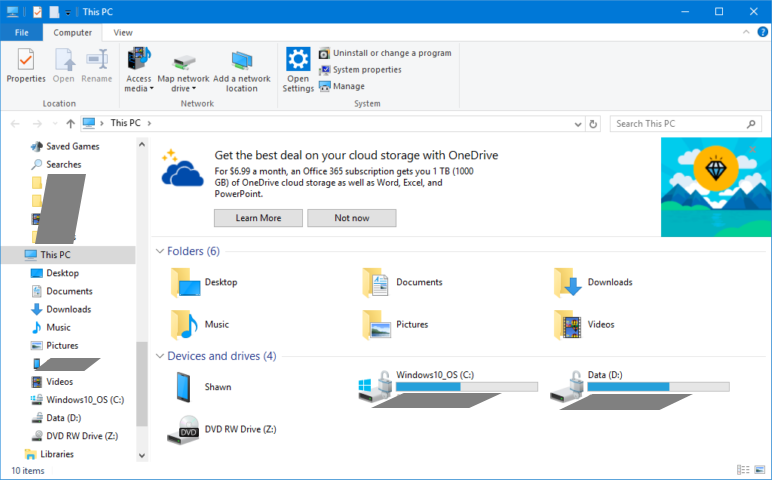The good news is that Microsoft is improving the state of privacy in Windows 10, albeit slowly, and grudgingly. The bad news is that the improvements are unlikely to satisfy anyone genuinely concerned about what Windows 10 is really doing.
New: Privacy Dashboard
A few days ago, Terry Myerson, Microsoft’s Executive Vice President of the Windows and Devices Group, announced a new web-based Privacy Dashboard, accessible via your Microsoft account. If you don’t have a Microsoft account, you’re out of luck. I’m still using my Microsoft account to log into my test system, because otherwise I’d have to buy a Windows 10 license. You probably already have a Microsoft account even if you don’t use Windows 10, as they are used for XBox Live, Skype, and other Microsoft services as well.
Poking around in the Privacy Dashboard, the Browsing History section is empty for me, presumably because I don’t use Cortana or Edge. The Search History section is also empty for me, because I don’t use Bing search. But if you use Cortana, Edge and Bing, you’d be able to see all that history here, and be able to remove it as well.
The Location section shows where you’ve been when you logged in on Windows 8.1 and 10 computers. Again, you can clear any or all of this. The section for Cortana’s database shows everything Cortana knows about you, based on your interactions. This is where things get interesting for me, because I only used Cortana for a couple of days when I first installed Windows 10. Cortana knows how often I eat at restaurants, and how far I go to get there. It knows my main mode of transportation. It knows what kind of news interests me. It’s not much, but it’s enough to be kind of creepy.
The Privacy Dashboard is a step in the right direction, and it’s very useful for anyone interested in seeing exactly what information Microsoft has collected. It also allows you to clear much of that information. But what if you want to prevent Microsoft from gathering this information in the first place?
Privacy improvements in Windows 10
Also revealed in Myerson’s post are upcoming changes to the privacy settings in Windows 10. The initial privacy setup has changed, and now provides a bit more information about the various privacy levels and settings. Microsoft is “simplifying Diagnostic data levels and further reducing the data collected at the Basic level.” But in fact there will be fewer privacy levels to choose from, and there’s still no real explanation of exactly what data is sent. And of course the most useful ‘Security’ level (which disables almost all telemetry) is only available to Enterprise users. Us regular folks can only throttle data collection down to the ‘Basic’ level.
According to Microsoft, the Basic level “includes data that is vital to the operation of Windows. We use this data to help keep Windows and apps secure, up-to-date, and running properly when you let Microsoft know the capabilities of your device, what is installed, and whether Windows is operating correctly. This option also includes basic error reporting back to Microsoft.” This sounds reasonable, but it’s lacking in detail and — for many users — still sounds like an intrusion.
Luckily, there are alternatives. I recently discovered a Powershell script called Reclaim Windows 10 that can disable all of the telemetry settings in Windows 10. I’ve yet to test the script, but it looks promising.
Advertisements in Windows 10?
Microsoft still insists this isn’t about advertising: “We want you to be informed about and in control of your data, which is why we’re working hard on these settings and controls. And regardless of your data collection choices, we will not use the contents of your email, chat, files, or pictures to target ads to you.” I’d like to believe that, but it seems unlikely. Microsoft is clearly taking aim at Google’s huge lead in online advertising, and the idea of having a captive audience for advertising (in the form of millions of Windows users) is obviously just too tempting to resist.
Microsoft continues to push Windows 10, now at the expense of Windows 7, which it now says “does not meet the requirements of modern systems, nor the security requirements of IT departments.”
Update 2017Jan18: Techdirt weighs in.

 boot13
boot13